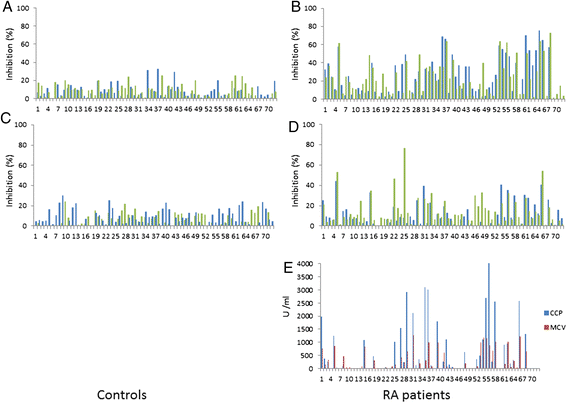Separate and overlapping specificities in rheumatoid arthritis antibodies binding to citrulline- and homocitrulline-containing peptides related to type I and II collagen telopeptides
- PMID: 25573503
- PMCID: PMC4320812
- DOI: 10.1186/s13075-014-0515-z
Separate and overlapping specificities in rheumatoid arthritis antibodies binding to citrulline- and homocitrulline-containing peptides related to type I and II collagen telopeptides
Abstract
Introduction: Our objective was to find out if there are antibodies binding to homocitrulline-containing type I and II collagen carboxyterminal telopeptides in sera of patients with rheumatoid arthritis (RA), and if these antibodies cross-react with citrulline and homocitrulline in the same peptide sequence.
Methods: A total of 72 RA and 72 control sera were analyzed for binding using enzyme-linked immunosorbent assay to citrulline- or homocitrulline-containing type I and II collagen carboxyterminal telopeptides, as well as to cyclic citrullinated peptide (CCP) and to mutated citrullinated vimentin (MCV). Specificities of the antibodies were tested using inhibition-ELISA.
Results: Of the RA sera, 39 (54%) and 41 (57%) were positive for binding to CCP and MCV, respectively. Further, 34 (47%) and 30 (42%) of the patients had specific antibodies binding to and being inhibited by citrulline-containing type I collagen telopeptides and by citrulline-containing type II collagen carboxyterminal telopeptides, respectively. The corresponding figures regarding homocitrulline-containing type I and homocitrulline-containing type II collagen telopeptides were 16 (22%) and 14 (19%). Most of the patients, who were seropositive for citrullinated peptides, showed binding in multiple assays. A total of 10 (14%) RA patients were positive for all the tested peptide pairs, while 28 (39%) of them had antibodies that contained overlapping specifities between citrulline and homocitrulline in the same peptide sequence.
Conclusions: Antibodies to both citrulline and homocitrulline containing type I and II collagen telopeptides can be found in sera of RA patients. These antibodies are not constant from one RA patient to another, but contain separate or overlapping specificities within the same peptide sequence varying between individuals. Our results suggest some relationship between citrulline and homocitrulline-recognizing antibodies, since homocitrulline antibodies exist mainly in individuals seropositive to anti-CCP and anti-MCV.
Figures


Similar articles
-
Ureido group-specific antibodies are induced in rabbits immunized with citrulline- or homocitrulline-containing antigens.Autoimmunity. 2016 Nov;49(7):459-465. doi: 10.3109/08916934.2016.1171853. Epub 2016 Apr 21. Autoimmunity. 2016. PMID: 27098309
-
Automated immunoassays for the autoantibodies to carbamylated or citrullinated telopeptides of type I and II collagens.Clin Chem Lab Med. 2015 Aug;53(9):1375-80. doi: 10.1515/cclm-2014-0683. Clin Chem Lab Med. 2015. PMID: 25389994
-
Sensitive immunoassays for the autoantibodies reacting against citrullinated carboxy-terminal telopeptides of type I and type II collagens in patients with rheumatoid arthritis.Clin Chem Lab Med. 2005;43(12):1400-5. doi: 10.1515/CCLM.2005.239. Clin Chem Lab Med. 2005. PMID: 16309380
-
Anti-citrullinated protein antibodies and their clinical utility in rheumatoid arthritis.Int J Rheum Dis. 2013 Aug;16(4):379-86. doi: 10.1111/1756-185X.12129. Epub 2013 Jul 15. Int J Rheum Dis. 2013. PMID: 23992255 Review.
-
Pitfalls in the detection of citrullination and carbamylation.Autoimmun Rev. 2018 Feb;17(2):136-141. doi: 10.1016/j.autrev.2017.11.017. Epub 2017 Dec 2. Autoimmun Rev. 2018. PMID: 29203292 Review.
Cited by
-
Specificity of Anti-Citrullinated Protein Antibodies in Rheumatoid Arthritis.Antibodies (Basel). 2019 Jun 7;8(2):37. doi: 10.3390/antib8020037. Antibodies (Basel). 2019. PMID: 31544843 Free PMC article.
-
Post-Translational Modifications of Proteins: Novel Insights in the Autoimmune Response in Rheumatoid Arthritis.Cells. 2019 Jun 29;8(7):657. doi: 10.3390/cells8070657. Cells. 2019. PMID: 31261953 Free PMC article. Review.
-
Significance of Type II Collagen Posttranslational Modifications: From Autoantigenesis to Improved Diagnosis and Treatment of Rheumatoid Arthritis.Int J Mol Sci. 2023 Jun 8;24(12):9884. doi: 10.3390/ijms24129884. Int J Mol Sci. 2023. PMID: 37373030 Free PMC article. Review.
-
Disordered Antigens and Epitope Overlap Between Anti-Citrullinated Protein Antibodies and Rheumatoid Factor in Rheumatoid Arthritis.Arthritis Rheumatol. 2020 Feb;72(2):262-272. doi: 10.1002/art.41074. Epub 2019 Dec 10. Arthritis Rheumatol. 2020. PMID: 31397047 Free PMC article.
-
Neutrophil extracellular trap-associated carbamylation and histones trigger osteoclast formation in rheumatoid arthritis.Ann Rheum Dis. 2023 May;82(5):630-638. doi: 10.1136/ard-2022-223568. Epub 2023 Feb 3. Ann Rheum Dis. 2023. PMID: 36737106 Free PMC article.
References
-
- Koivula MK, Heliovaara M, Ramberg J, Knekt P, Rissanen H, Palosuo T, et al. Autoantibodies binding to citrullinated telopeptide of type II collagen and to cyclic citrullinated peptides predict synergistically the development of seropositive rheumatoid arthritis. Ann Rheum Dis. 2007;66:1450–1455. doi: 10.1136/ard.2006.062919. - DOI - PMC - PubMed
-
- Aletaha D, Neogi T, Silman AJ, Funovits J, Felson DT, Bingham CO, 3rd, et al. 2010 rheumatoid arthritis classification criteria: an American College of Rheumatology/European League Against Rheumatism collaborative initiative. Ann Rheum Dis. 2010;69:1580–1588. doi: 10.1136/ard.2010.138461. - DOI - PubMed
Publication types
MeSH terms
Substances
LinkOut - more resources
Full Text Sources
Other Literature Sources
Medical

